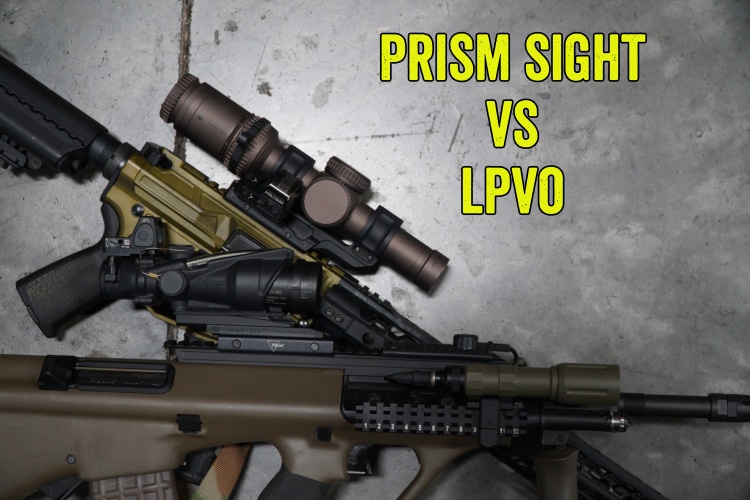
Should You Carry With A Round Chambered?
Explore carrying with a round chambered with True Shot Academy. Learn the benefits of carrying with a round in the chamber and more.

Hey all, we here at True Shot Academy are going to be going over prism sights and LPVOs today. These two kinds of optics are incredibly popular among shooters these days and have proven themselves to be effective. Our goal with this blog post is to compare these two types of optics while delving into their features and traits. Without further ado, let’s talk about prism sights and LPVOs.
A prism sight is similar to a traditional style scope due to its use of prismatic lenses. These types of sights set themselves apart from red dots and holographic sights with their etched reticles. These reticles will always be visible, even without power, providing a shooter with a permanent reticle. Prism sights will generally be fixed power optics and are available in a variety of magnification levels. One can find optics of this type in 1x, 2x, 3.5x, 4x, and 6x varieties just to name a few. Prism sights will typically feature some form of illumination from sources such as batteries, tritium, and fiber optics.
The reticle of a prism sight is often dependent upon the level of magnification it provides. Prism sights on the lower end of the magnification spectrum and those offering no magnification will typically feature simple reticles. These reticles are less busy than reticles intended for longer-range shooting and are optimal for fast target acquisition at close range. The offerings in higher magnification levels will generally feature a reticle of the bullet drop compensator (BDC) variety. These reticles are intended to help a shooter engage targets at extended ranges. These reticles in these higher magnification levels can also be specifically calibrated for a given cartridge and barrel length. For example, a 4x Trijicon TA31RCO-A4CP is optimized for a 20” barrel firing a 62 grain 5.56x45mm NATO round.
A low power variable optic, or LPVO, is a traditional style scope which covers a low range of magnification. Typically, LPVO scopes do not exceed 10x magnification. Common offerings span 1-4, 1-6, 1-8, and 1-10 magnification ranges. These types of optics bridge the gap between close range and longer-range shooting as they seek to cover the low and high ends of magnification. LPVOs are also available with or without illuminated reticles.
LPVOs are also available in either first focal plane (FFP) or second focal plane (SFP) form. FFP scopes feature a reticle which has a size corresponding to the current level of magnification. At lower magnification levels, the reticle will appear to be smaller and more simplistic. As the level of magnification increases, the reticle will grow in size and be at its largest and most complex at the highest level. It is at this highest level of magnification where one can best use a BDC type reticle and expect a reticle’s markings for holds and other information to be most accurate. SFP scopes feature a reticle which stays the same time at all magnification levels.
Pros:
Cons:
Pros:
Cons:
There are a fair number of prism sights available on the market. These types of sights are manufactured by companies such as Trijicon, Armament Tech, Vortex Optics, and Hawke Optics to name a few. These optics are available at multiple price points with budget and premium options to be considered. Typically, these types of optics are made in the United States or China.
There number of LPVO offerings on the market considerably outweighs the number of prism sights on the market. Offerings of LPVO scopes can be had from companies such as Leupold, Trijicon, EOTech, Nightforce, and Vortex Optics to name a few. Like most optics, LPVOs are available at both budget-oriented and premium price points. These types of optics are usually made in countries such as the United States, Japan, Germany, the Philippines, and China.
At the end of the day, both prism sights and LPVOs have proven themselves to be versatile and reliable sighting solutions. Regardless of whether one goes with a prism sight or an LPVO, they should train to be proficient and efficient with their optic of choice. To build proficiency, you will need to invest time and ammunition to develop and hone skills. We here at True Shot Ammo carry a wide variety of ammunition well-suited to training and practice and are here to help you get stocked up. As always, happy shooting.
Need bulk ammo? At True Shot Ammo, we have a wide variety of handgun ammo and rifle ammo available to purchase. Please visit our website trueshotammo.com, call us at (888) 736-6587, or you can email us at [email protected] for more ammo options.
View more posts about optics:

Explore carrying with a round chambered with True Shot Academy. Learn the benefits of carrying with a round in the chamber and more.

Explore SBR considerations with True Shot Academy. Learn what an SBR is, how you can legally get one, their pros and cons, and more.

Discover the disposable nature of magazines with True Shot Academy. Learn about why they wear, how to keep your magazines going, and more.